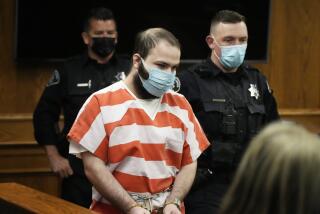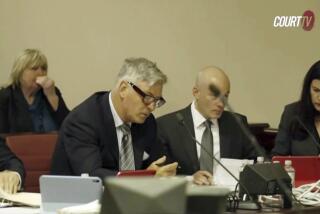Battle of Influence Turns Directly to the Jury
After weeks of indirectly trying to influence potential jurors through the media, the prosecution and defense in the O.J. Simpson case began their face-to-face campaigning Tuesday.
It was the first day of voir dire, the questioning of a pool of men and women who will provide the 12 jurors and eight alternates for Simpsonâs trial.
As it does in all jury trials, Wednesdayâs voir dire operated at two levels, each of importance to whether Simpson is convicted or acquitted in the murder of his former wife, Nicole, and her friend, Ronald Goldman.
One was obvious. Superior Court Judge Lance A. Ito, Deputy Dist. Atty. Marcia Clark and defense attorney Johnnie L. Cochran Jr. wanted to probe the beliefs and psyches of the panel members and determine whether they could decide Simpsonâs fate on evidence presented in the trial, rather than what they have learned from all the publicity.
The second level was more subtle. Voir dire questioning provides an opportunity for the lawyers to introduce themselves to the jurors, who will be their daily courtroom companions until the trial concludes, possibly at the end of January.
*
After spending the morning at the Criminal Courts Building, I called a jury expert for an interpretation of what had happened. Her name is Terri Waller, and she is managing partner of the National Jury Project, a Berkeley based jury consulting firm.
âIt is fairly common for lawyers, particularly in the first part of jury selection, to set the stage, and introduce the jurors to the kinds of questions they are concerned about,â she said. âFor both sides, it is the first time the jurors will get an inkling, through the questioning, of the various theories that the prosecution and defense will pursue. The jurors are moving from the realm of what they have learned in the news media into the real case.â
In addition, Waller said, âIn any case, particularly one that will take so long a time, the lawyers are certainly interested in establishing rapport between themselves and the jurors, establishing their integrity and their skills.â
The first juror in the box was a 52-year-old woman employed by the county tax department. After Ito asked her a few questions, it was Cochranâs turn.
Like most of the reporters, I was not in the courtroom and had no way of seeing the proceedings. We were in a room three floors above, listening to the piped-in proceedings on a small but powerful speaker. So my impressions come from my ears, not my eyes.
Cochran demonstrated the charm of a talented political candidate. He has a pleasant manner, a warm smile and he remembers names. He told the woman he hoped she wouldnât be like a juror heâd read about: âHe liked to make up his mind at the beginning so he could sit back and enjoy the proceedings.â We heard laughter from the courtroom, a rare occurrence so far in the proceedings.
The woman spoke softly. âYou wonât be shy and bashful?â Cochran asked, wondering whether she would speak her mind in the jury deliberations. âYou have a very quiet voice.â
Marcia Clark was next. Portrayed by some of the media as being too aggressive, Clark moved quickly to draw her own image of herself for the jurors. She was friendly, soft-spoken and showed concern for the juror. âAre you nervous?â she asked. No, the woman replied. âYou wonât hold it against me if I ask just a few questions?â Clark said.
The questioning also gave the first indications of where the prosecution and defense are headed.
Cochran asked about race, and pointed out that the woman was the product of an interracial marriage between white and Filipino parents. Simpson is African American and his ex-wife was white.
He wanted to know whether the woman, who had been active in police Neighborhood Watch when she lived in Seattle, believes the police or coroner could make mistakes. Yes, she said. The defense essentially had begun casting suspicion on the investigatory abilities of the Los Angeles Police Department and coronerâs office personnel who investigated the murder.
For her part, Clark was interested in the womanâs educational background, including her knowledge of science. Thatâs a significant point. The prosecution is hoping that DNA, the substance that is a blueprint for human development, will prove Simpson guilty. Prosecutors hope to show that Simpsonâs blood was found at the death scene, and blood matching that of the victims was discovered on a glove at his home.
*
It was, in sum, a day for potential jurors to get acquainted--with the case and with the attorneys. As jury consultant Waller said: âThis is going to be a long trial. These people are going to be in each otherâs lives for a long while.â
More to Read
Get the L.A. Times Politics newsletter
Deeply reported insights into legislation, politics and policy from Sacramento, Washington and beyond. In your inbox three times per week.
You may occasionally receive promotional content from the Los Angeles Times.










